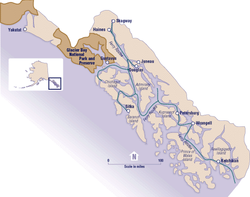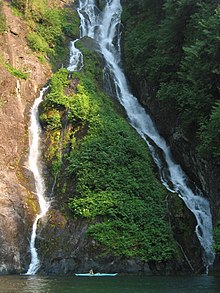Southeast Alaska, sometimes called the Alaska Panhandle is the southeastern portion of the U.S. state of Alaska. It is west of the northern half of the Canadian province of British Columbia. A lot of the Panhandle is part of the Tongass National Forest, which is the biggest National Forests in the United States. This part of Alaska is known for its mild rainy temperate oceanic climate and beautiful scenery.


Geography
changeSoutheast Alaska is the end of the Inside Passage. The Inside Passage a way to get to Alaska by boat or ship without having to go out in the open ocean. It begins all the way down in Puget Sound in Washington state. This was a way for native canoeists to get around. Later during the gold-rush steam ships used it. Today it is used by ferries and cruise ships. The Panhandle has a land area of 35,138 miles (56,549 km). This is only 6.14% of Alaska's land area, but the Panhandle is bigger than Maine, and almost as big as the state of Indiana. The 2000 census population of the Panhandle was 72,954 people. About 42% of them live in the city of Juneau.
There are lots of parks and forests in Southeast Alaska, and many islands. The largest islands are, Chichagof Island, Admiralty Island, Baranof Island, and Prince of Wales Island. On August 20, 1902, President Theodore Roosevelt opened the Alexander Archipelago Forest Reserve, which became the Tongass National Forest later.
Climate and wildlife
changeSoutheast Alaska is a temperate rainforest within what is called the Pacific temperate rain forest zone. The most common trees are evergreens like the Sitka spruce and the Western hemlock. Wildlife you might see on land there include brown bears, black bears, wolves, and deer. In the ocean there are humpback whales, orcas, five species of salmon and many other kinds of fish. Some of the birds in the area are Bald Eagles, and many kinds of gulls, ducks, and other seabirds and waterfowl.
Cities and towns
changeThe big cities in Southeast Alaska are Juneau, Ketchikan, and Sitka. Some other towns are Petersburg, Wrangell, Angoon, Craig, Klawock and Skagway. There are also many very small towns and villages, with less than 100 people in them.
Culture
changeMany tribes of Natives have lived in Southeast Alaska for a long time. This biggest group are called the Tlingit people. A long time ago another people called the Haida lived there. Today people called the Tsimshian live there too. The region is close to Seattle and the American Pacific Northwest and has a lot in common with that area.
Industry
changeA lot of people in Southeast Alaska work in commercial fishing or tourism . Logging also used to be done a lot there.
Transportation
changeBecause of all the mountains, glaciers, and towns on islands in Southeastern Alaska, almost all the towns except Hyder, Skagway, and Haines have no roads that go to other places. Airplanes and boats are the major means of transport. The Alaska Marine Highway passes through Southeast Alaska.
Other websites
change- The regional economy of southeast Alaska: final report / prepared for Alaska Conservation Foundation; prepared by Steve Colt, Darcy Dugan, Ginny Fay (EcoSystems). Hosted by Alaska State Publications Program Archived 2007-10-12 at the Wayback Machine.
- Southeast Alaska energy export study: final report / prepared for The Southeast Conference; by D. Hittle & Associates, Inc., in association with Commonwealth Associates, Inc. Hosted by the Alaska State Publications Program Archived 2007-10-12 at the Wayback Machine.
- Swan - Tyee intertie economic analysis / prepared for the Four Dam Pool Power Agency; prepared by CAI, Commonwealth Associates, Inc. Hosted by Alaska State Publications Program Archived 2007-10-12 at the Wayback Machine.
57°34′48″N 135°29′14″W / 57.58000°N 135.48722°W